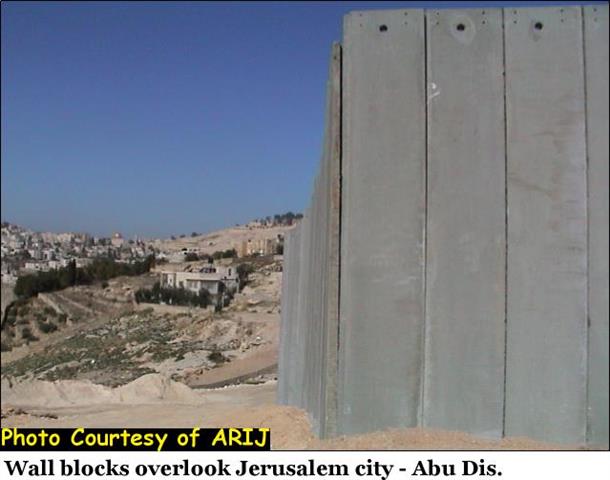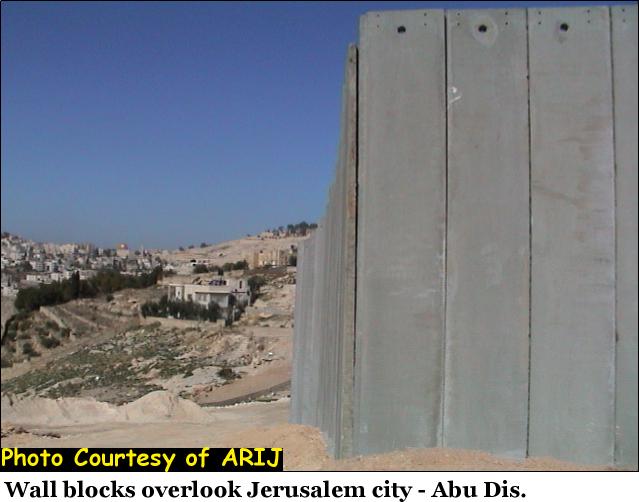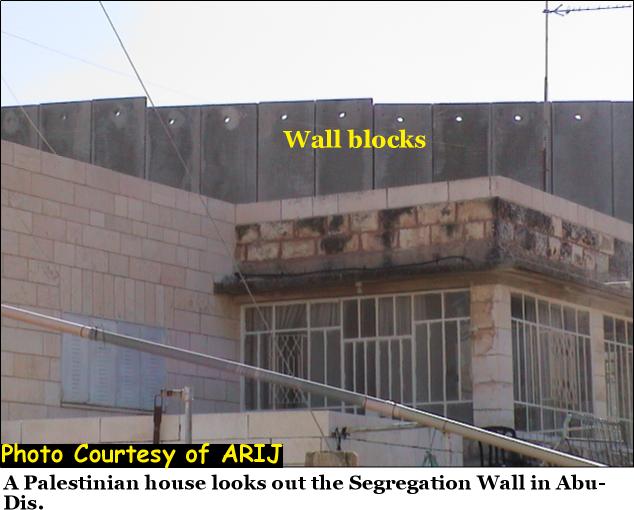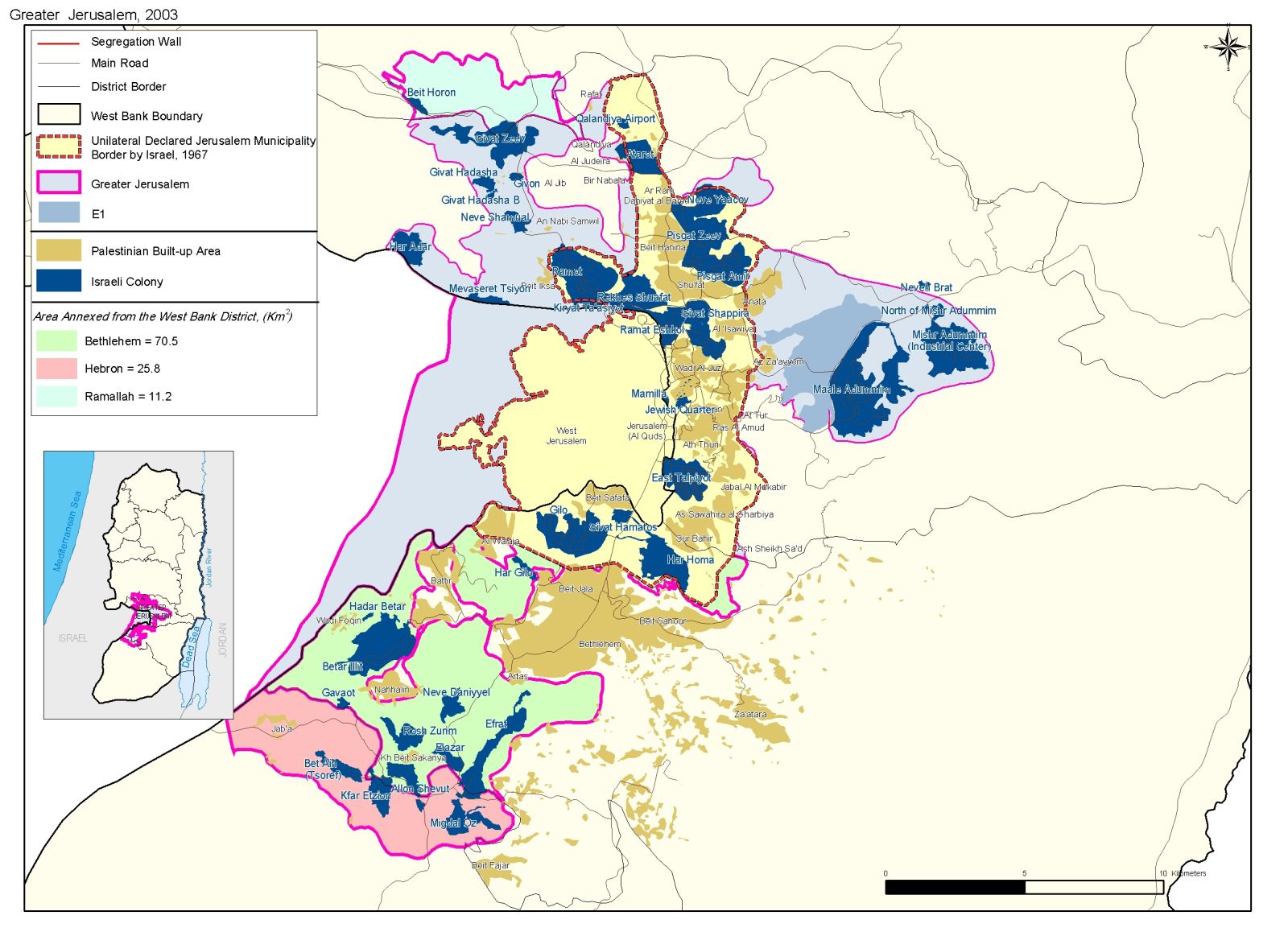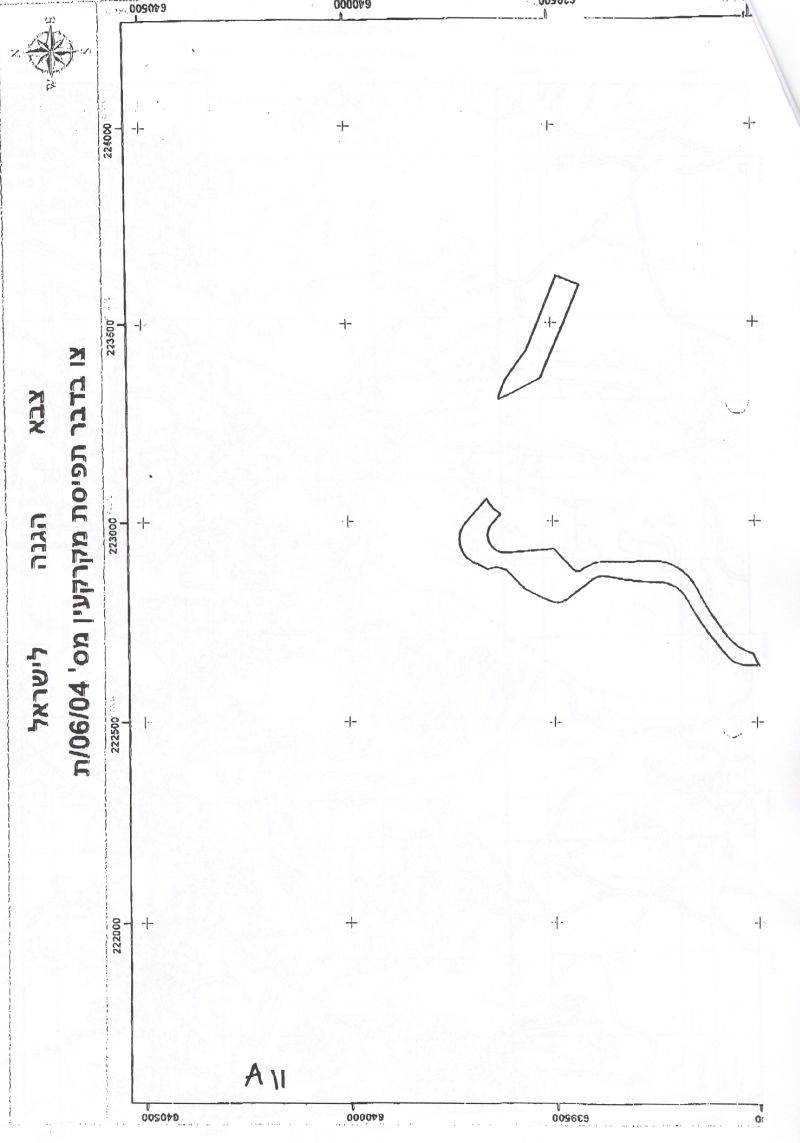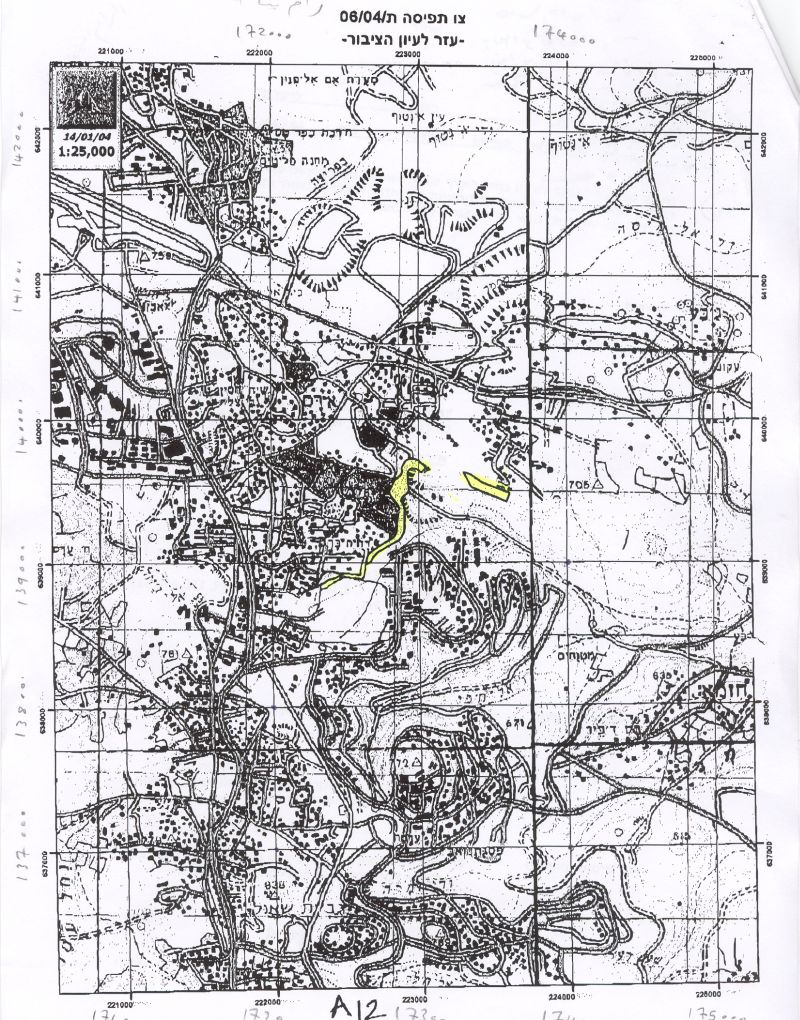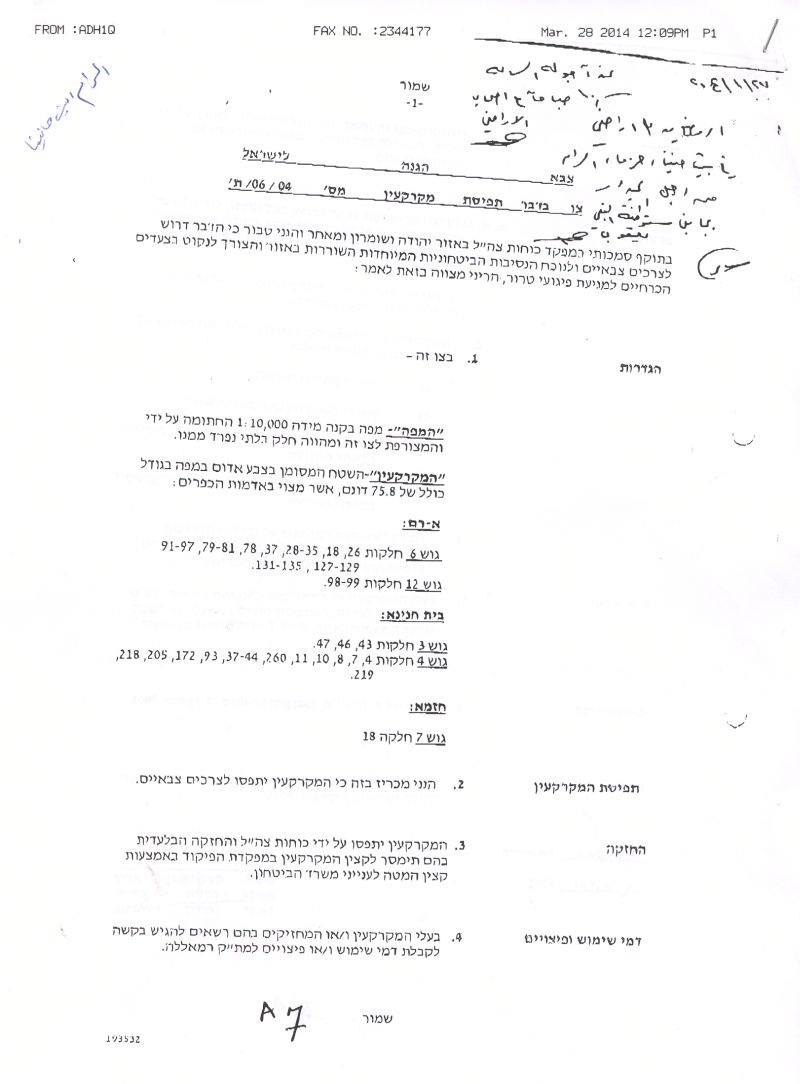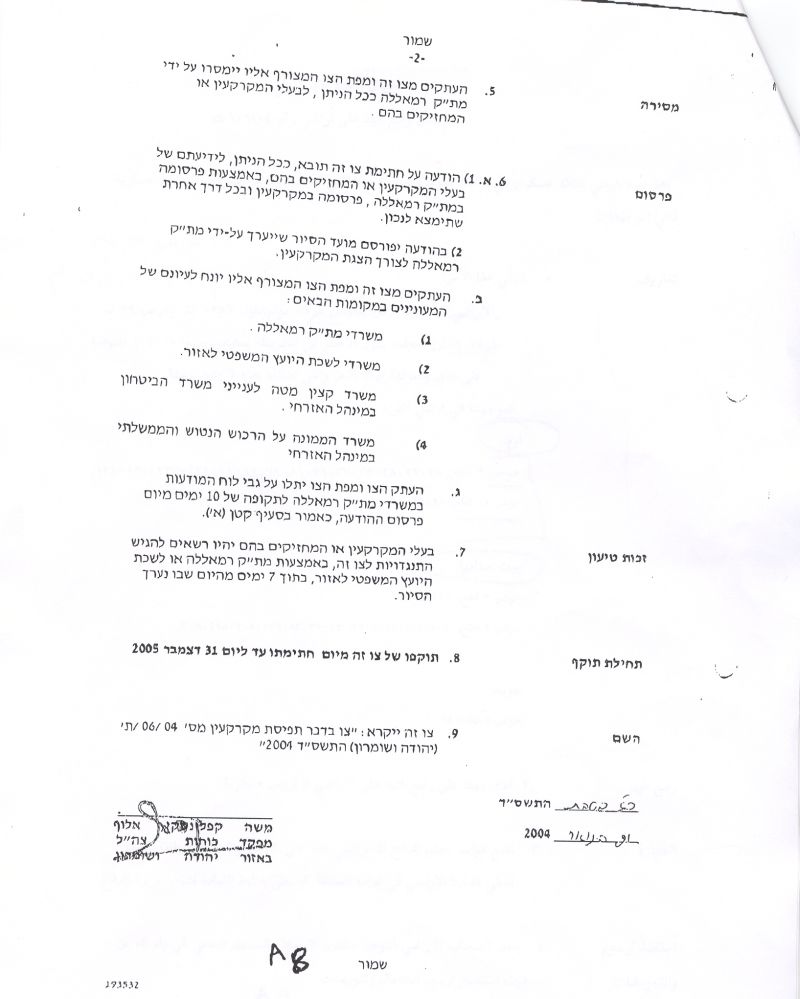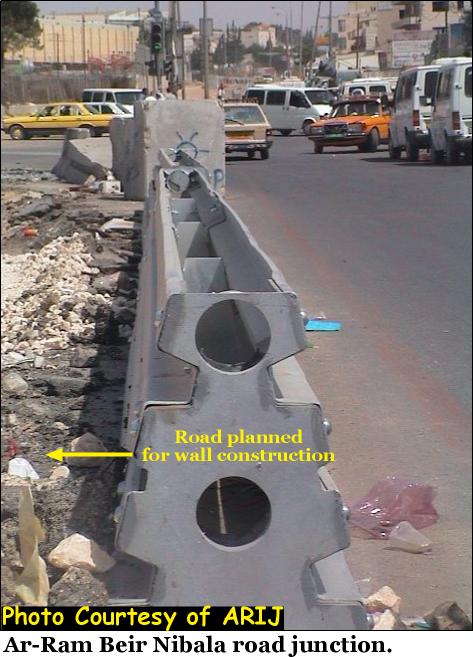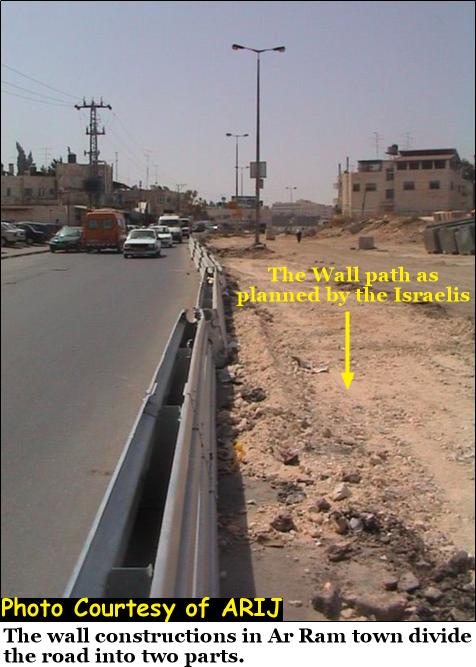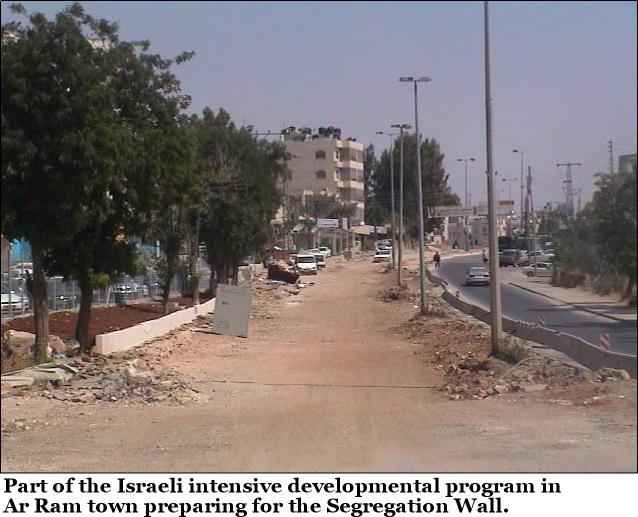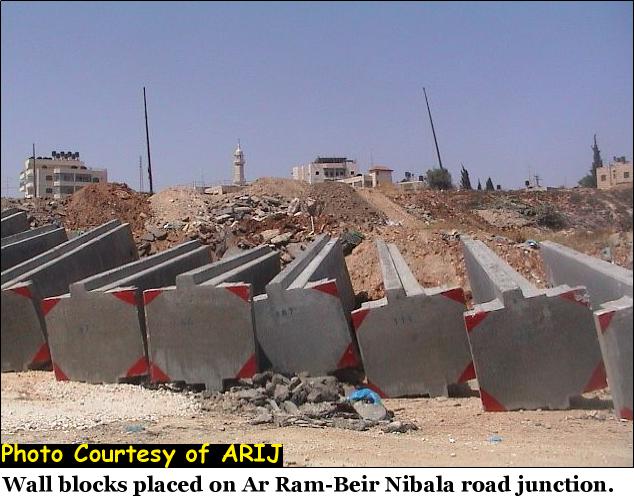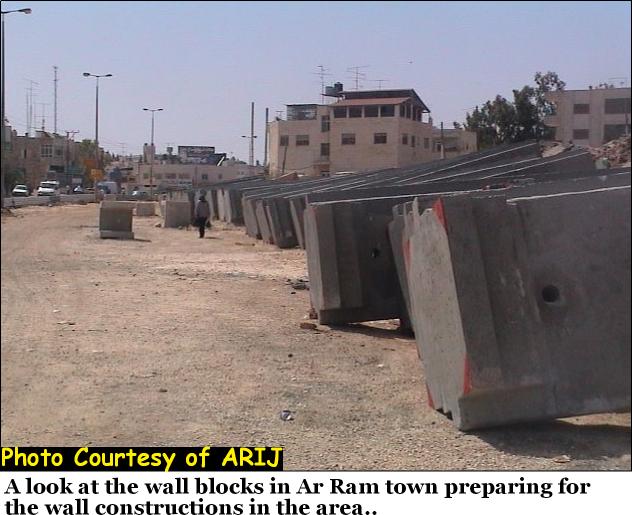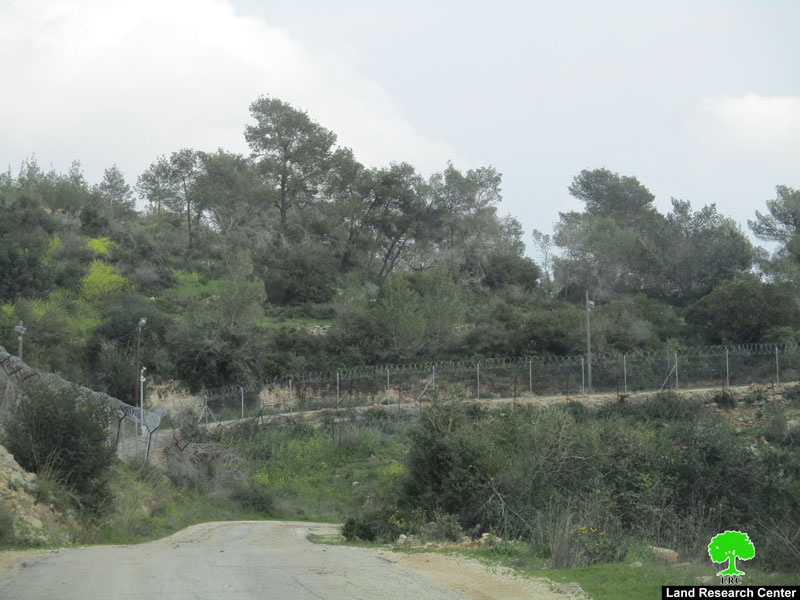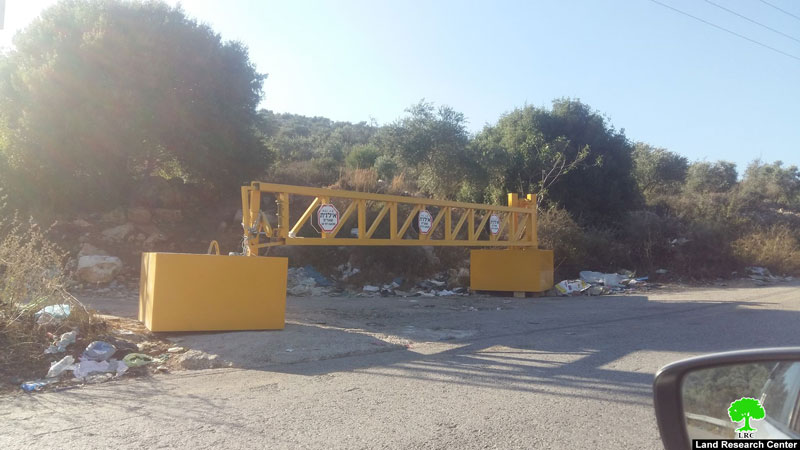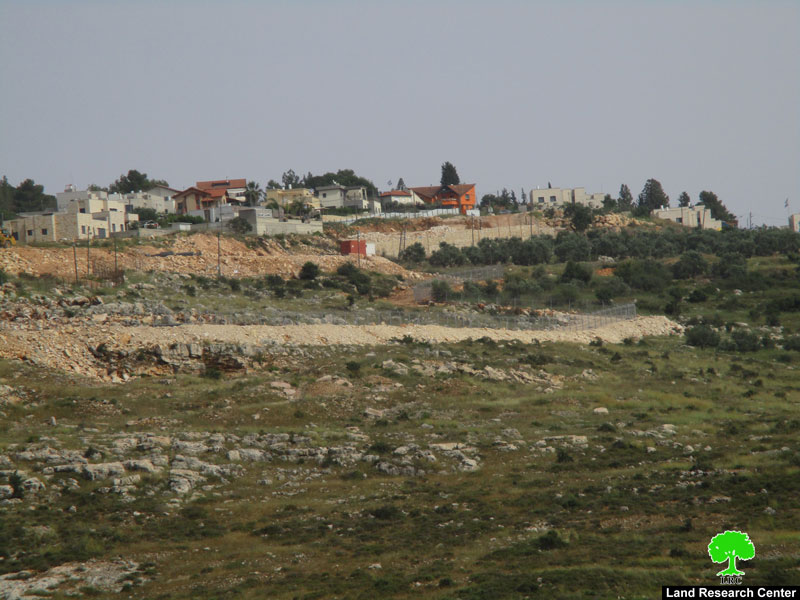Ar Ram, a Palestinian town in east Jerusalem, located approximately 7 kilometers north of East Jerusalem city center. During the Roman period, this town was known as Al Ramah and later known as Ar Ram. It has remains of ancient building, cisterns, walls and quarries. It has the hamlets of Kherbet Erha, Kherbet Addasa, Kherbet Deir Sallam, and Kherbet Ras Et Taweel. These contain several archeological sites such as cisterns building foundations, walls and rock-cut wine presses. It was one of the first and major actions Israel followed after the 1967 war to secure and maintain exclusive Israeli sovereignty over the city of Jerusalem through a series of ''as though-legal'' methods, which according to the Israeli government:
1. Obstructing the Palestinian development through a series of biased policies most of which hindering the process of issuing permits for building on lands or utilizing lands for other purposes. Such policies still form a kind of difficulty on Palestinians wishing to prosper. Such policies served the Israeli Government in a way that made the preservation of Palestinian lands in Jerusalem until they are expropriated for exclusive Jewish use.
2. The focus of the successive Israeli governments over settlement activities following the 1967 war to facilitate the expropriation of lands from Jerusalem into Israel proper.
3. Despite the Declaration of Principles (DOP) on the 13 of September 1993 between the PLO and Israel, which called for a total and immediate freeze of all colonization activities including those in East Jerusalem, construction and land expropriations continued unabated under the various Israeli governments starting from Rabin Government (1993-1995) up today.
Israel regularly ignored international laws such as the 1949 Forth Geneva Convention and UN Security Council resolution 242 of 1967 which affirmed that ''All Members shall settle their international disputes by peaceful means in such a manner that international peace and security, and justice, are not endangered. All Members shall refrain in their international relations from the threat or use of force against the territorial integrity or political independence of any state, or in any other manner inconsistent with the Purposes of the United Nations.''
This resolution is considered a key resolution that Israel has refused to fulfill and continued its land expropriation policy from the West Bank and Jerusalem ; thus creating irreversible facts on the ground to exert a supreme control over the landscape of Jerusalem despite the fact that Oslo Accords are based on it.
Land Confiscation history following the 1967 War:-
Israel, throughout the 37 years of occupation has endorsed and implemented stages of land expropriation in order to control the holy city of Jerusalem. In March of 1980, Israel confiscated 4,500 dunums from Beit Hanina and Hizma villages (in the north) in an attempt to reinforce the Jewish existence in those areas (Neve Yacov and Pisgat Zeev) and to create a contiguity spot with previously confiscated lands from villages such as Shiek Jarrah, Lifta, Issawyeh and Shu'fat, from which 4000 dunums were expropriated in 1968. The eviction of Palestinian Arab families from Al Magharabe neighborhood built on 120 dunums of land in 1967, the expropriation of 14000 dunums of lands from Beit Jala (southwest), Al Malha and Sur Baher (south), and further confiscation of lands from Um Tuba, Sur Baher, Beit Sahour, Bethlehem, Beit Safafa and Beit Jala estimated by 2000 dunums for the construction of Jewish settlements. (The Judiazation of Jerusalem by by Allison Hodgkins, Passia 1996)), Al Malha and Sur Baher (south), and further confiscation of lands from Um Tuba, Sur Baher, , , Beit Safafa and Beit Jala estimated by 2000 dunums for the construction of Jewish settlements. (
The Segregation Wall
Israel declared on June 16, 2002 the construction of a Segregation Wall between the West Bank and Israel which was supposed to be built parallel to the 1948 Armistice borders. The Wall is designed to embrace and annex all Israeli settlements, valuable Palestinian agricultural lands and groundwater resources within the West Bank east of the Green Line. . The Wall is designed to embrace and annex all Israeli settlements, valuable Palestinian agricultural lands and groundwater resources within the West Bank east of the Green Line.
The wall plan ever since declared by the Israeli government in June 2002, various military orders were issued to confiscate Palestinian lands considered as properties of the State of Israel as declared in the orders. The installation of high concrete wall blocks in the West Bank is not a rationale for the security of the Israeli citizens as the Israeli government claims, but long termed land grab policies to gain control of more Palestinian territories. See Photo 1 & Photo 2
Palestinian towns and villages affected by the Israeli Wall plan:-
ARIJ staff visited the Palestinian villages located north of Jerusalem city. Their observation findings and the data gathered were analyzed following the field work. According to the analysis, a total of six Palestinian villages are threatened by the Israeli plan to build the Segregation Wall. The villages are Ar Ram, Hizma, Beit Hanina El Tahta, Beir Nibala, Al Jib, and Al Judera.
Ar Ram town in east Jerusalem is one of the most affected villages by the construction of the Wall and is now undergoing an intensive Israeli development construction at favor of the Segregation Wall. The Wall which is planned by Israel to surround Jerusalem from its northern and southern borders is part of the Israeli so-called ''Jerusalem Envelope plan''. See map of Jerusalem. at favor of the Segregation Wall. The Wall which is planned by Israel to surround Jerusalem from its northern and southern borders is part of the Israeli so-called ''
Chronology of events:-
On August 2002, Israel issued a military order to construct the Segregation Wall to the north of Jerusalem municipality border. The order was issued based on the emergency material law of 1949 for land seizure which Israel handled its implementation to the Israeli ministry of defense and real-estate department.
-
(a) A competent authority may, by order under his hand, order the requisition of land. Such an order shall be called a 'land requisition order'.
-
(b) The competent authority may take possession of land in respect of which a land requisition order has been made, and so long as the order is in force, he, and only he, may occupy, use and exploit the land, either himself or through others, as he may deem necessary for the purpose for which the order was made). For more information about law, click here..
Israel violated law since:
-
Occupied Jerusalem following the 1967 war was governed by civil law; and
-
It gave Palestinians no chance to object the order since is it is implemented by Israeli higher authorities
According to the emergency material law of 1949, Israel was either supposed to give the land back to its real owners after a non-extended period of 3 years or confiscate it. But, in fact, this law gave Israel the green light to seize more lands from Palestinians for security purposes and based on it's will.
The flagrant violation caused the annexation of the area mentioned in the military order at favor of expanding Jerusalem municipality borders. The actual work to erect the corresponding part of the Segregation Wall around Jerusalem started on the 22nd of August 2002 at the village of Rafat. See map of Rafat
The plan extended to include more lands from villages located to the North of the Jerusalem city such as Ar-Ram, Qalandia, Kufr Aqeb, El Bireh (Rafat al Massioun) and Rafat. The area of the isolated lands was estimated at 500 dunums that time ; in addition to 300 dunums of land that were considered as military restricted area and security zone along the path of this Wall.
The Israeli plan to build the Segregation wall in the West Bank and mainly around Jerusalem city became atop of Israel's priorities, turning the process of what is left from the West Bank into isolated cantons, segregating the Palestinian people between wall blocks and the Israeli settlements.
The Israeli occupation forces, resumed on May 17, 2004, its Segregation plan in the area between Qalandyia, Dahyet Al Barid and Al Ram outskirts. The Israeli bulldozers started razing tens of dunums of lands in El Barid outskirt, 'Ayad neighborhood and the Coptic outskirt in El Ram town preparing for the Wall construction. On May 25, 2004, the IOF handed residents of Ar Ram, Hizma and Beit Hanina outskirts located at the northern edges of Jerusalem city military order along with maps showing the path of the Segregation Wall planned for the area. See Translation of military order:-
Order to Seize lands n0 04/06/T
March 28, 2004
According to my authorities as a Military Chief Commander in the Region of Judea and Samaria, and as I believe that it is imperative for military reasons due to the special security situation in the region, I order the following:
1. Lands:
1. The ''Map'' signed with a scale of 1: 10000 and attached to the order is an essential part of this order.
2. The ''Lands'': 75, 8 dunums (1256 meter long and 29 -75, 8 meters wide) and marked in red in the map. Lands are located in:
|
Location |
Block No. |
Parcel |
|
Al Ram |
6 |
18, 26, 28-35, 37, 79, 81, 78, 97-91,129-127,135-131 |
|
|
12 |
98, 99 |
|
Beit Hanina |
3 |
43, 46, and 47. |
|
|
4 |
7,8,10,11,260,44, 37,93,172,205,218,219 |
|
Hizma |
7 |
18 |
See maps of military order as provided by the Israelis. Page 1 & Page 2
2. I announce by that the above mentioned lands are seized for military reasons.
3. The IOF seize the lands and have an absolute control over it that is given to the officer of the central command officer of lands who is responsible in the ministry of defense.
4. These copies are to be given by the District Co-ordination Office ''The DCO'' of Ramallah to the owners of land.
5. Copies are found with maps for those who are interested in the following places :
-
District coordination office (DCO) of Ramallah.
-
Offices of the juridical advisor in the region.
-
The office of commander responsible in the ministry of defense in the civil administration.
-
Office responsible of absentee and public lands in the civil administration.
6. The owners of land have the right to go to the DCO in Hebron in order to get more information about their right of land use expenses and compensation in a maximum duration of 7 days.
7. The Validity of this order starts at the date signed till 31/12/2005.
8. The name of this order is: ''Order to seize lands n0 04/06/T (Judea & Samaria) 2004.
Mosheh Kaplenski
Chief Commander of the Israel Defense Forces in Judea & Samaria
-Signature
See copies of military order, page one & page two
The Israeli military bulldozers again started on the 28th of May, 2004 to mark out the territory of Ar Ram (the main doorway between Ramallah and Jerusalem), located 7km to the north of Jerusalem city, preparing for the construction of the Segregation Wall in the area and limiting the movement of people and vehicles on the road leading to it. See Photo 3 & Photo 4
According to the Israeli plan, the wall route runs 1 Km long along the main road of Ar Ram town to reach Qalandyia checkpoint, separating Ar-Ram town into two parts, as seen in Photo 3 and Photo 4, and isolating thousands of Palestinians living on the right side of Ar Ram city (those who live on the Jerusalem side) from its left one (those who live on the West Bank side of Ar Ram).
Officials in Ar Ram town see that the ''under construction'' Segregation Wall will block the access of Palestinian residents living in Ar Ram specifically those living on the left side of the town to Jerusalem city (Direction: from Qalandyia checkpoint heading to Ar Ram), where most of the residents (90%-95%) are Jerusalem ID holders''
Residents will not have access to educational, health and business facilities provided by the municipality of Jerusalem to Ar Ram city although residents of Ar Ram pay the Arnona (a tax charged by the municipality of Jerusalem on buildings). Arnona tax payment is estimated according to the state, quality, location and size of the building, no matter of the type of the building whether commercial or residential. Commercial buildings or properties are rated by their size and not by their commercial activity.
Although Palestinian Jerusalemites pay same rates of Arnona as Israelis, the following issues arise:-
-
The average income of an Israeli person living in Jerusalem (East or West) is eight times higher than Palestinian Jerusalemite. Source: (Israeli CENTRAL Bureau OF STATISTICS).
-
Palestinian Jerusalemites Arnona payments contribute t0 approximately 50% of the Municipality's total budget designated for services. Palestinian Jerusalemites only receive 10% of the total budget for service while Israelis residing in Jerusalem receive 4 to 6 times of the budget. Source: (Israeli CENTRAL Bureau OF STATISTICS).
-
Palestinian Jerusalemites must provide papers that prove their residency in Jerusalem city when they ask for services or benefits provided by the national Insurance institutes in Jerusalem such as child allowance, maternity benefits and rehabilitation.
Impact of the Wall on the Educational System
The construction of the Wall in Ar Ram will also lead to devastating results to the educational system. If the wall construction is completed in Ar Ram area, it will block the road leading to the following villages like Beir Nibala, Al Jib, Al Judera, Beit Surik, Shu'fat, Samir Amis, Jerusalem and Kufr 'Aqab.
-
Students, who hold Jerusalem IDs and attend schools in Ar Ram city, will have to quit their schools and move out to join others in Jerusalem.
-
Students, coming from the above mentioned areas (Beir Nibala, Al Jib, Al Judera, Beit Surik, Shu'fat, Samir Amis, and Kufr 'Aqab ) excluding Jerusalem fear that it will be impossible in the near future to attend schools situated in Ar Ram and Al Dahia outskirts everyday and from one side to another. The Wall blocks which are about to be positioned in Ar Ram area will block the access of those students to schools and force them to search for other alternative and time-consuming roads in addition to checkpoints to reach their schools. Such students will also prefer to quit their place in school and attend schools in their area.
-
Teachers, who hold Jerusalem IDs and have Jobs at schools of Ar Ram city, will have to quit their Jobs and move out to work in schools situated in Jerusalem.
-
Schools, situated in Both Jerusalem and the eastern outskirts might lose their artificial-character; or might witness a decline in the academic performance due to the new comers (of students) who might be less proficient.
-
The Construction of the Wall will also have economical effects on families whose children attend governmental schools and might have to move out to other schools with higher educational expanses. Below is a table of a number of schools situated in between Ar Ram, Al Dahia and attended by students and teachers from Both, the West Bank and Jerusalem. See table below
|
School Name |
Total #of Teachers |
Total number of students |
Students who reside in Jerusalem outskirts/percent |
Students who reside in West Bank areas |
Teachers coming from Jerusalem |
Teachers coming from West Bank areas |
|
Al Iman School |
— |
850 |
— |
— |
— |
— |
|
Al Umma high schools for boys |
|
400 |
200 |
200 |
One third |
Two third of the teachers are west Bank residents. |
|
Husni Al-Ashab Elementary School |
25 |
548 |
One third of the students |
Two third of the students |
— |
All of the teachers are West Bank ID holders |
|
Al Baironi elementary school |
15 |
340 |
One third of the students |
Two third of the students |
2 |
13 |
|
Rosary Sisters School (a new school campus) |
— |
830 |
— |
All are Jerusalem ID holders |
— |
— |
The impact of the Segregation Wall on the commercial sector:-
Ar Ram is considered a main Commercial center that is threatened by the construction of the wall. It will negatively affect the town economic condition due to the division of communities caused by the wall. The Wall is currently undergoing developmental constructions according to the Israelis and is lined up on both sides with commercial stores, organizations (profit and non profit ones) in addition to Nusaiba housing project and other residential buildings. Some Palestinian Jerusalemites (currently residing in Jerusalem and the nearby villages), have businesses/commercial stores on both sides of the road. In addition to Palestinians Jerusalemites who also reside on the left side of Ar Ram (direction: from Qalandyia checkpoint to Ar Ram) have commercial shops on the threatened side of Ar Ram.
-
Palestinian Jerusalemites who reside on the threatened side of the Wall (the left side in particular) and run a business will have two choices in the near future. They either give up their rights to keep the Jerusalem ID or sell their properties including their business in Ar Ram city and move out to live and work in Jerusalem to avoid being excluded from the city facilities and services when the wall is completely constructed.
-
Traders and business owners from Ar Ram and Al Dahia fear that customers from Jerusalem and the nearby villages will not be able to reach their area if the construction of the Wall is completed. This in return will cause a catastrophic economic situation in the area.
The Israeli Supreme Court and the Wall:-
In light of the Israeli Supreme court ruling on June 30 2004 to reroute 30 kilometer out of 40 Kilometers line Wall in areas located around Jerusalem, the reroute doesn't cancel out the Wall constructions, but decide to change its path in a way to make a balance between Israeli security needs and the needs of Palestinians living in these areas. See Photo 5 (Wall foundations in Ar- Ram outskirt))
Humanitarian issue:-
Fida, an employee at the Applied Research Institute-Jerusalem and a resident of Dahyat Al Barid suburb talks about the latest Israeli intensive program in Ar Ram and Dahyat Al Barid suburbs and its effect on her daily life.
Fida's parents lived in Beit Hanina ever since they got married in 1974 up to 1982. They later moved to live in a new house in Al Ezzariya town, located in Area B in which the Palestinians have full control over civil society except that Israel continues to have overriding responsibility for security according to Interim agreement in 1995. They lived in Al Ezzariya town for almost 21 years (till 2003) as her father used to work at Al Quds University up to that time.
Since the signing of Oslo peace agreements in 1993, the Israeli government has been adopting a series of attacks against Palestinian residency rights in Jerusalem. In 2003, members of the Israeli ministry of social affairs visited Fida's house in Ezzariya town and asked for papers to prove that their 'center of life' lies within Jerusalem municipality boundaries or else they'll have their Jerusalem residency rights revoked as Jerusalemites. Since that time up to day, Fida's family were deprived access to public health services and national rights (Cut off Health insurance and national Insurance), not forgetting to mention that Fida's family are Jerusalem ID holders. As Palestinian Jerusalemites taking up residence outside Jerusalem municipal boundaries fearing to forfeit their right to residency in Jerusalem, Fida's family were forced to seek a house within the Jerusalem municipal boundaries so as not to have their housing rights (residency rights) revoked under the slogan 'center of life' obligation.
The Israeli ministry of social affairs and the Israeli ministry of interior are related in that , once a person looses his rights of health services and and national rights, he/she also losses the rights maintained for a Jerusalem ID holder.
Fida's family ( 6 family members) lived in Dahyat Al Barid, in an area located within Jerusalem municipality boundaries. They pay a house rent of 700 USD a month in addition to Arnona tax (1), water and electricity bills. The fact that a Palestinian residing in Jerusalem is required to pay Arnona at same rates as an Israeli resident does, seem to be an unfair and discriminate policy applied by the Israeli government since an Israeli resident earns eight times higher than a Palestinian Jerusalemite does (Israeli CBS); Besides, Jerusalemites, according to the Israeli CBS:
1. receive less than 10% of the municipal budget;
2. the city invests four-six times as much on a Jewish resident as on a Palestinian resident.
3. Severe shortage of services (water and sanitation, repairs and maintenance of roads, street lightening etc.) in East Jerusalem. The following table demonstrates some of the discrepancies:
|
|
East Jerusalem |
West Jerusalem |
|
Length of sewage pipes (km, 1999) Average no. of persons per km of sewage pipe (1999) |
76 2,809 |
650 743 |
|
Total length of roads (km) (1999) Average no. of persons per km of roads (1999) |
87 2,448 |
680 710 |
|
Total length of sidewalks (km) (1998) Average no. of persons per km of sidewalks (1999) |
73 2,917 |
700 690 |
|
Social welfare centers (employees) (2000) |
3 (42) |
20 (252) |
|
Families receiving social welfare services (no. of family members) |
8,442 (28,400) |
42,357 (86,800) |
|
Mother & child health care centers No. of children up to 6 years per mother & child center |
5 68,822 |
32 1,821 |
|
Public gardens (1999) |
29 |
1,079 |
|
Swimming pools (1999) |
0 |
36 |
|
Sport facilities (1999) |
33 |
531 |
|
Playgrounds (1999) |
2 |
1,451 |
|
Libraries (2001) |
4 |
36 |
|
Ordinary municipal budget (for running expenses) (2000, %) |
8.69-11.18 |
88.82-91.31 |
|
Extraordinary budget (for development projects) (2000, %) |
9.5 |
90.5 |
|
Investment in the water infrastructure (NIS) |
2,723,000 |
26,450,000 |
|
Investment in sewage and sanitation (NIS) |
13,000,000 |
30,500,000 |
(Sources: JCSER, Fact Sheet on Municipal Services, 2002; JSCER, Chronic Racial Discrimination in East Jerusalem, 2003; PCBS, Jerusalem Statistical Yearbook, no. 5, 2003).
Till the date of writing this report, health and national rights of Fida's family are still revoked by the ministry of social affairs although they've been living within Jerusalem municipal area for more than one year and have been paying all their dues ever since they moved to this date. Fida's father suffers from sickness (high blood pressure, high cholesterol, high uric acid). He has been paying money for his medicine for almost one year (ever since he was his insurance rights were dropped by the ministry of social affairs). With all the expanses Fida's family has to pay such as (Arnona, water and electricity bills), they're also deprived from a crucial need which also causes a financial burden on the family.
Feda's day starts when she leaves home in Dahyat Al Baird suburb at 6:20 in the morning heading to work. Before the Israelis began their intensive construction programs for the Segregation Wall in Ar Ram area, Fida used to take the following transportation line in order to get to her job at ARIJ:-
|
|
Transportation direction |
Transportation Cost |
Estimated Time |
|
1. |
From Dahyat Al Barid to Dahyat Al Barid Checkpoint |
1.5 NIS |
5 minutes |
|
2. |
From Dahyat Al Barid Checkpoint to Jerusalem |
3.5 NIS |
Usually it takes 20 to 25 minutes but but most of the times it depends on the mood of Israeli soldiers guarding the checkpoint which causes a delay up to 1 hour. |
|
3. |
From Jerusalem to Al Khadr Checkpoint (Bus) |
5 NIS |
Usually the bus heading to Al Khadr checkpoint undergoes several Israeli security checks (4) through which people are asked for their IDs to be checked which also cause a delay from 30 to 45 minutes |
|
From Jerusalem to Al Khadr checkpoint (Taxi) |
7 NIS |
||
|
5. |
From Al Khadr Checkpoint to Bab Al Ziqaq (Main cross road between Beit Jala and Bethlehem city). |
1.5 NIS |
5 Minutes |
|
6. |
From Bab Al Ziqaq to ARIJ Institute |
1.5 NIS |
Couple of minutes |
|
|
Total Cost |
15 NIS (13 NIS) |
|
Fida' takes 6 transportation means in order to get to her Job at ARIJ, in addition to the 15 NIS (13NIS ) she spends everyday on transportations (a total of 330 NIS a month).
Now that Ar Ram is undergoing some constructional works by the Israelis preparing for the Segregation Wall, things have changed to Fida and she had to seek other ways to get to her workplace at ARIJ. The following summarizes the new changes caused by the Israeli constructions in the area:
|
|
Transportation direction |
Transportation Cost |
Estimated Time |
|
1. |
From her house to Dahyat Al Barid checkpoint |
walking |
15 minutes |
|
From Her house to Qalandia checkpoint |
1.5 NIS |
15 minutes as well |
|
|
2. |
From Qalandia checkpoint to Jerusalem through Atarot road |
5 NIS |
There exist a checkpoint on Atarot road which usually causes a delay up to 30 minutes to people trying to pass it, depending on the mood of the Israeli soldiers guarding the checkpoint. |
|
3. |
From Jerusalem to Al Khadr Checkpoint (Bus) |
5 NIS |
Usually the bus heading to Al Khadr checkpoint undergoes several Israeli security checks (4) through which people are asked for their IDs to be checked which also cause a delay from 30 to 45 minutes |
|
From Jerusalem to Al Khadr checkpoint (Taxi) |
7 NIS |
||
|
5. |
From Al Khadr Checkpoint to Bab Al Ziqaq (Main cross road between Beit Jala and Bethlehem city). |
1.5 NIS |
5 Minutes |
|
6. |
From Bab Al Ziqaq to ARIJ Institute |
1.5 NIS |
Couple of minutes |
|
|
Total Cost |
16.5 NIS (14.5 NIS) |
|
In reality, the Segregation wall is a crime against humanity. If completed, it will put thousands of Palestinians in an open prison. The undergoing constructions in Ar Ram negate the Israeli claims of building the Wall on 1967 borders at the same time, violate all international human rights.
(1): Arnona: A tax system at which Palestinians are required to pay on buildings, both commercial and residential by the Jerusalem municipality (or local municipality).
(2) Security check at Jaffa gate
Security Check at Tel Pyot
Security Check at Beit Safafa entrance and
Security check at Beit Jala entrance
Prepared by:
The Applied Research Institute – Jerusalem


